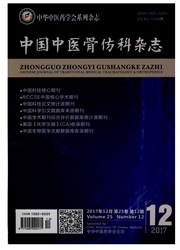

 中文摘要:
中文摘要:
目的:评价解剖学和影像学方法观察寰枢关节(AAJ)及相关结构的优缺点及应用价值。方法:对8例寰枢关节段尸体解剖标本进行解剖学和影像学对比研究,观察椎动脉寰枢段(VA-A)、第1、2脊神经(CN1,CN2)以及AAJ滑膜皱襞(SF)的解剖,测量它们的大小及位置关系值。结果:CN1出椎管后向外下走行于寰椎后弓上缘及VA下缘,CN2出椎管后走行于寰、枢椎后弓之间及VA后。SF存在于寰枢中央前关节6例,寰枢外侧关节5例。VA-A沿AAJ走行,有4个弯曲,其中第2、4个弯曲远离其骨结构。CN1、CN2到VA-A距离范围分别为0.0~2.2 mm、0.0~3.6 mm,VA2个弯曲行程远离AAJ骨结构距离范围分别为0.0~4.8 mm、2.0~7.9 mm,解剖及影像测量值统计学比较差异无统计学意义(P〉0.05)。结论:解剖学方法有利于观察CN和SF,影像学方法显示VA-A与AAJ清楚。两者具有互补性,得到的测量值相当,结合应用为研究该区域的复杂解剖提供了新的手段。
 英文摘要:
英文摘要:
Objective:To evaluate the application and characteristics of anatomy and imageology in observing atlanto-axial joint(AAJ) and relational structures.Methods:AAJ segments of 8 cadaveric specimens were studied with both anatomical and imaging methods.Vertebral arteries of AAJ segment(VA-A),the first and second cervical nerve(CN1,CN2),and synovial fold(SF) of AAJ were observed and measured.Results:After extending from vertebral canal,CN1 goes between the posterior arch of atlas and VA-A,and CN2 passes between the posterior arch of the atlas and axis posterior to VA-A.Among the 8 cases,SF in central anterior AAJ was found the 6 cases and in articulatio atlantoaxialis lateralis in 5 cases.VA-A goes along AAJ with 4 curves,in which the second and fourth VA-A were away from the bone structure of AAJ.The distance from CN1,CN2 to VA-A and that from the second,fourth curve of VA-A to AAJ is 0.0~2.2mm,0.0~3.6mm and 0.0~4.8mm,2.0~7.9mm,respectively.There was no significant difference between the measurements of anatomical and imaging method(P0.05).Conclusion:Anatomical method has advantages in obseving the CN and SF,while the imaging method shows clearly and directly the VA-A and AAJ.Both are mutually complementary with consistent measurements.The combination of two methods provides a new way to study the complicated anatomy in this region.
 同期刊论文项目
同期刊论文项目
 同项目期刊论文
同项目期刊论文
 期刊信息
期刊信息
